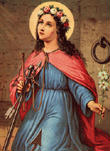
The exceptional quantity of miracles which resulted from the petitioning of the martyr invoked as "Philomena," initially by the southern Italian faithful, and then shortly thereafter by peoples of various countries, has been officially documented in various ecclesiastical recordings. Both the extensive documentation from the St. Philomena Shrine at Our Lady of Grace Church in Mugnano, (11) and the documentation for the beatification and canonization processes of John Vianney at Ars, record the remarkable quantity of miracles attributed to the intercession of St. Philomena, which included the miraculous cure of Vianney himself. (12) In 1833, Bishop Anselmo Basilici of the Diocese of Nepi and Sutri requested a feast and office in honor of St. Philomena from the Holy See, with the local ordinary from Nola having prepared a lesson for the breviary in her honor. (13) The Basilici petition received the support of a significant number of Italian bishops, in spite of its unusual status due to the absence of reference to St. Philomena in any martyrology or in any other historical account. The loculus name, Filumena, and the ubiquitous miracles acquired through her intercession as testified by numerous Church authorities sufficed for many of the Italian hierarchy in substantiating the legitimacy of the petition. (14) On September 6, 1834, the Congregation of Rites submitted to Pope Gregory XVI the formal request for the approval of the office and mass in honor of St. Philomena, virgin and martyr, due to the repeated request for this liturgical cult and veneration by several prelates. (15) On June 17, 1835, the Congregation of Rites also concluded positively to a documented miracle submitted by Bishop Casilici and other bishops and priests, which testified to a multiplication of bone dust derived from the sacred remains. (16) In the dossier submitted to the Congregation, several bishops and clergy testified to the inexplicable multiplication of bone dust originating from a few grams ("one pinch"), which then provided bone dust for well over 700 reliquaries without the original amount experiencing any decrease in quantity. Other experiments were conducted with numerous Church and civil witnesses, only to observe and testify to the same phenomenon of multiplication. (17) |